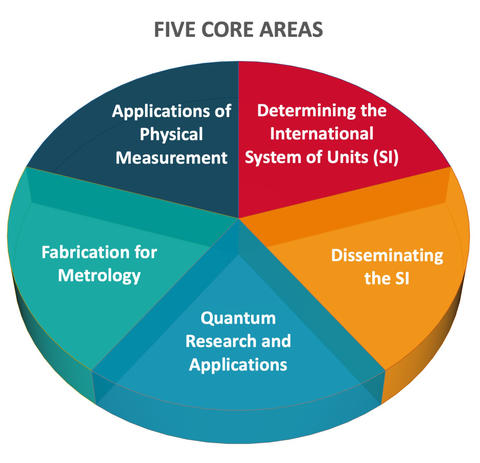About PML

The Physical Measurement Laboratory (PML) sets the definitive U.S. standards for nearly every kind of measurement in modern life including mass, time, frequency, temperature, electricity, and electromagnetic radiation. As a world leader in the science of physical measurement, PML develops procedures and tools that enable continual progress in quantifying and disseminating these standards, all of which are essential to industry, medicine, the research community, and government. PML also supports research in many fields of urgent national importance, such as manufacturing, energy, electronics, radiation, communications, lighting and display, transportation, the environment, remote sensing, space exploration, health, law enforcement, homeland security, and military defense.
PML’s efforts in FY 2024 span five core areas:

1. Determining the International System of Units (SI)
PML has the primary responsibility for realizing and disseminating the authoritative values for the SI base units in the U.S, which since 2019 are based on fixed values of natural physical constants. Measuring the SI units with the highest possible accuracy requires the constant development of new technologies and methods of precision measurement.
2. Disseminating the SI
Disseminating SI units is essential for industry, academia, and government to ensure the accuracy of measurements critical to their missions. U.S. manufacturers rely on NIST’s measurement services to satisfy the requirements of conformity, accreditation, and traceability, thus allowing access to global markets.
3. Quantum Research and Applications
Because quantum mechanics is key to precision measurement, PML researchers explore the ultimate limits of quantum technologies and train the next generation of measurement scientists in partnerships with other government agencies and universities. PML also uses the quantum properties of light and matter for building optical atomic clock and quantum sensors, creating quantum networking and quantum information processing systems, and performing quantum simulations.
4. Fabrication for Metrology
Fabricating and measuring devices on the nanoscale (billionths of a meter) has become an integral part of metrology for PML. This ability enables PML to create compact, accurate, precise, and easily deployable measurement devices and systems that frequently take advantage of phenomena only accessible at the nanoscale. PML resources such as the Center for Nanoscale Science and Technology play a key role in creating the microsystems that support such programs as NIST on a Chip and the CHIPS Metrology effort.
5. Applications of Physical Measurement
PML metrology advances include new capabilities to accurately measure and calibrate the intensity of electromagnetic radiation and subatomic particles over a broad range of energies using spectrometers, radiometers, and imaging systems. PML applies these capabilities to improve and expand measurements in climate and atmospheric sciences, weather and space-weather forecasting, astronomy and cosmology, medical imaging, homeland and supply-chain security, and advanced manufacturing.
PML is participating in the American Physical Society - Inclusion, Diversity, and Equity Alliance.
Contacts
General Information: 301-975-4200 (phone); 301-975-3038 (Fax); 100 Bureau Drive, M/S 8400, Gaithersburg, MD 20899-8400
-
PML webmaster

